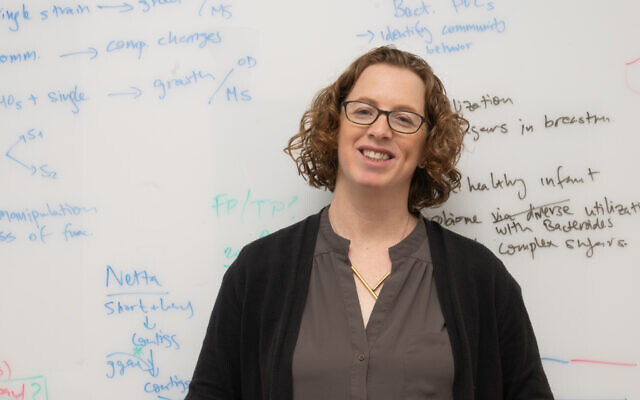
Credit: Times of Israel - Renee Ghert-Zand
A group of researchers from the Hebrew University and Hadassah Medical Center have demonstrated the success of pooled saliva PCR testing for universal screening for congenital cytomegalovirus (cCMV) in newborns.
CMV, the condition caused by infection by cytomegalovirus (CMV), is the most common congenital viral infection among newborns. Fetuses contract the infection via the placenta, yet medical centers rarely universally screen for it after birth.
There is an average worldwide prevalence of around seven cCMV infections per 1,000 live births. Approximately 20 percent of infected babies develop hearing problems or neuro-developmental deficits, or both. These health challenges are diagnosed anywhere from birth until about age 10.
CMV is most often transmitted through saliva and urine, and pregnant women often pick it up through direct contact with young children in the home or other close-contact settings.
Saliva has long been used to test for cCMV in newborns and a positive saliva result is always followed up by a urine test to confirm the diagnosis.
Israeli researchers have shown that pooled testing allows medical staff and labs to screen huge numbers of patients by combining single tests into groups and it was implemented routinely during the COVID-19 pandemic. If a pooled sample comes back negative, no further tests are needed. If a pooled sample comes back positive, then each sample within that group is retested for the viral sequence.
A peer-reviewed study published in early March by Israeli researchers in the high-impact Nature Medicine journal demonstrates how sensitive pooled saliva tests make detecting cCMV reliable, logistically feasible, and cost-effective enough to be able to move beyond targeted testing only of newborns who do not pass a hearing test or whose mothers are known to have been infected with the virus during pregnancy.
According to the study’s authors, targeted testing of symptomatic newborns is insufficient when approximately 90% of infected newborns are asymptomatic. Ten to 15% of these children will go on to develop complications.
“The standard practice of targeted testing is not enough,” said Prof. Dana Wolf, director of clinical virology at Hadassah University Medical Center and a Hebrew University professor.
Wolf collaborated on the research involving 15,805 infants born over 13 months at the two Hadassah hospitals in Jerusalem. Other members of the team were Hebrew University computational biologist and assistant prof. Moran Yassour and the Hadassah neonatology team headed by Prof. Smadar Eventov Friedman.
“Over 93% of the parents agreed to have their baby screened. It makes a massive difference going from testing 10% to testing almost all the babies born at the hospitals,” Yassour said.
 Moran Yassour, assistant professor at the Hebrew University, affiliated with both the Faculty of Medicine and the School of Computer Science. (Ariel Van Straten)
Moran Yassour, assistant professor at the Hebrew University, affiliated with both the Faculty of Medicine and the School of Computer Science. (Ariel Van Straten)
Yassour explained that Hadassah started using pooled PCR testing for COVID-19 during the pandemic and considered implementing the same approach for universal cCMV screening.
“We swabbed the babies’ mouths to collect the saliva. We put the swabs into a tube containing a [liquid] buffer that maintains the [viral] sequences in it,” Yassour explained.
“Then we took one-eighth of the liquid from each tube and combined it with the same amount from seven other samples. Then we tested the pooled sample,” she continued.
Yassour, who co-founded the computational medicine center at the Hebrew University, noted that pooling is not new and dates back to the 1940s when political economy professor Robert Dorfman pioneered it at Harvard.
However, she used her expertise to comb through all the positive cCMV test results from 2014 to 2021 to figure out if it was theoretically possible to come up with accurate results using the pooling technique, which involves diluting each sample. The key was to not over-dilute to the point where the viral sequence could not be properly detected.
Following theoretical calculations and successful pilot testing, the final study showed no loss in virus-detecting sensitivity due to the pooling. The approach resulted in the sparing of 83% of saliva tests, had individual testing of all 15,805 newborns been required.
In addition, over 96.18% of the pools were negative, obviating the need for retesting individual samples.
“The accuracy of this approach allowed us to also greatly reduce the number of follow-up urine tests we had to do on newborns. Getting a urine sample from a baby is quite difficult. You have to put a bag [over the genitals inside the diaper] and wait, and it’s really an annoying procedure,” Wolf said.
Ultimately, 54 out of 15,805 infants in the study were identified with cCMV using urine confirmatory testing.
According to Yassour, a heartening side effect of the pooled testing was a reduction in false positive results.
“An earlier study Prof. Wolf and others did showed that saliva was a good first filter for detecting the virus in newborns, but many of the babies who tested positive by saliva ended up testing negative by urine,” Yassour said.
“With the pooling scheme it may seem like our sensitivity is dropping because of the dilution, but really what is happening is that now all the samples that were previously borderline positive are being filtered out and they are actually negative,” she said.
Wolf stressed the importance of early detection of cCMV and proper follow-up, which may be treatment with antiviral medications, ongoing close observation of the child’s hearing and development, or both.
“On a positive note, although there are no official guidelines requiring the testing of Israeli pregnant women for CMV, de facto 80-90% of obstetricians have their patients tested,” Wolf said.
“We see this increased testing of pregnant women in Western European countries. The world is generally moving towards universal screening of pregnant women, but we are not there yet. But in Israel, it’s very advanced,” she said.
Back to Newsletter